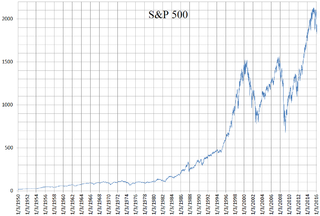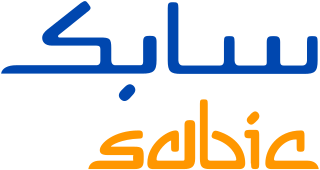Related Research Articles

The Nasdaq Stock Market is an American stock exchange based in New York City. It is the most active stock trading venue in the U.S. by volume, and ranked second on the list of stock exchanges by market capitalization of shares traded, behind the New York Stock Exchange. The exchange platform is owned by Nasdaq, Inc., which also owns the Nasdaq Nordic stock market network and several U.S.-based stock and options exchanges. Although it trades stock of healthcare, financial, entertainment, retail, and food businesses, it focuses more on technology stocks.

The Standard and Poor's 500, or simply the S&P 500, is a stock market index tracking the stock performance of 500 of the largest companies listed on stock exchanges in the United States. It is one of the most commonly followed equity indices and includes approximately 80% of the total market capitalization of U.S. public companies, with an aggregate market cap of more than $43 trillion as of January 2024.
The Forbes 500 was an annual listing of the top 500 American companies, produced by Forbes magazine. The list was calculated by combining five factors: sales, profits, assets, market value, and employees. The list was last issued in March 2003 ; it is no longer calculated each year and has been replaced by the Forbes Global 2000, which includes non-U.S. companies but is calculated on a similar basis as the old Forbes 500.
The Forbes Global 2000 is an annual ranking of the top 2000 public companies in the world, published by Forbes magazine. "The Global 2000" annual ranking is assembled by Forbes using a weighted assessment of four metrics: sales, profit, assets and market value. The list has been published annually since 2003.

Saudi Basic Industries Corporation, known as SABIC, is a Saudi chemical manufacturing company. 70% of SABIC's shares are owned by Saudi Aramco. It is active in petrochemicals, chemicals, industrial polymers and fertilizers. It is the second largest public company in the Middle East and Saudi Arabia as listed in Tadawul.
A middle-market or mid-market company is one that is larger than a small business and smaller than a big business. Different authorities use different metrics to compare company sizes — some look at revenue, others at either asset size or number of employees — with the result that different authorities give different definitions of the "middle market".
The S&P 100 Index is a stock market index of United States stocks maintained by Standard & Poor's.

Coal India Limited (CIL) is an Indian central public sector undertaking under the ownership of the Ministry of Coal, Government of India. It is headquartered at Kolkata. It is the largest government-owned-coal-producer in the world. It is also the ninth largest employer in India with nearly 272,000 employees.
Samsung Life Insurance (Korean: 삼성생명보험) is a South Korean multinational insurance company headquartered in Seoul, South Korea, and a subsidiary of the Samsung Group. It is the largest insurance company in South Korea and a Fortune Global 500 company.
The Fortune Global 500, also known as Global 500, is an annual ranking of the top 500 corporations worldwide as measured by revenue. The list is compiled and published annually by Fortune magazine.

In finance, a stock index, or stock market index, is an index that measures the performance of a stock market, or of a subset of a stock market. It helps investors compare current stock price levels with past prices to calculate market performance.
References
- ↑ "FT Global 500 2010". www.ft.com. Retrieved 2024-06-13.